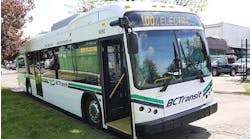Crews on Tuesday will start installing the first solar energy project along TriMet's 52-mile MAX light-rail system.
The unique 253-panel array will wrap around the south terminus substation and signal-communications building at Portland State University and will create more than 67,000 kilowatts of power per year, according to TriMet. The transit agency initially estimated the project costs would run $750,000, but the current budget has dropped to $370,600.
"The difference in price is mainly due to the shake out the industry has been going through," said TriMet agency architect Bob Hastings. "We're delighted to be the recipients of that price drop."
But the solar power is expected to offset only $3,680 of annual electric costs, which means a decades-long payoff for the new system. Hastings said the agency is still learning how best to maximize integration of renewable energy.
"For us, we see it as a pilot project. We're learning a whole lot about the industry and how all of this stuff works both in terms of technical knowledge as well as the whole funding and permitting processes," he said. "We'll apply that to future light rail projects."
The project is funded by leftover money from the MAX Green Line project, an Energy Trust of Oregon rebate and Portland General Electric. REC Solar will install the SolarWorld panels, which will feed into PGE's power grid through a power purchasing agreement.
The initial plans for the South Terminus also included 275 watts of wind power generated by mini urban turbines - a product of Portland-based startup, Oregon Wind. TriMet still hopes to incorporate vertical axis wind turbines, Hastings said, but Oregon Wind no longer appears to be a viable partner.
"Oregon Wind has come up against some challenges with their product and company, but the city of Portland expressed a desire to partner with us on making that happen. We are still open and would love to find another company, hopefully from the city of Portland, or the metro region, or even the state of Oregon," he said.
The necessary support poles, conduits and electrical cabinets are already in place for a future wind installation. Selecting a provider of the turbines and locating funding for the installation remain hurdles.
"Like everything else, we have to make sure it's a viable product that will last for the long-term so we can recoup our investment," Hastings said.
Copyright 2008 LexisNexis, a division of Reed Elsevier Inc. All rights reserved.
Terms and Conditions | Privacy Policy


